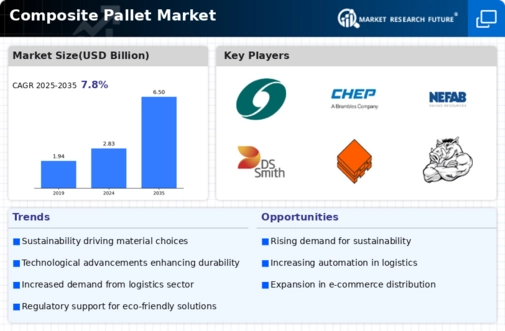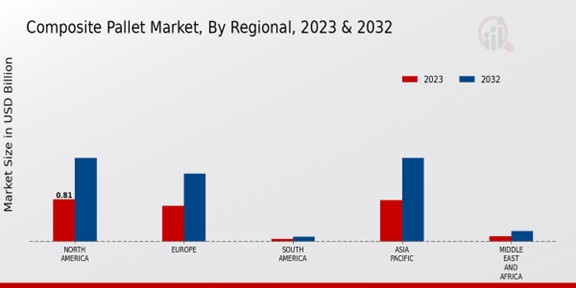Cost Efficiency
Cost efficiency remains a pivotal driver in the Global Composite Pallet Market Industry. Composite pallets, while initially more expensive than traditional options, offer long-term savings through durability and reduced maintenance costs. Their lightweight nature contributes to lower shipping costs, making them an attractive option for logistics companies. As businesses increasingly seek to optimize their supply chain operations, the financial advantages of using composite pallets become apparent. This trend is likely to bolster market growth, with the industry projected to reach 2.83 USD Billion in 2024, reflecting the growing recognition of cost-effective solutions in logistics.
Global Trade Dynamics
The dynamics of global trade are significantly impacting the Global Composite Pallet Market Industry. As international trade continues to expand, the demand for efficient and reliable shipping solutions increases. Composite pallets, known for their lightweight and durable characteristics, are becoming a preferred choice for exporters and importers alike. Their ability to withstand various environmental conditions makes them suitable for diverse markets. The ongoing globalization of supply chains suggests a robust growth trajectory for composite pallets, with the market expected to reach 2.83 USD Billion in 2024, reflecting the increasing reliance on efficient logistics solutions.
Regulatory Compliance
Regulatory compliance is increasingly influencing the Global Composite Pallet Market Industry. Governments worldwide are implementing stringent regulations regarding packaging and transportation, particularly concerning sustainability and waste management. Composite pallets, which often meet or exceed these regulations, provide a viable solution for companies looking to comply with environmental standards. For example, the European Union's directives on waste reduction and recycling are prompting businesses to transition to more sustainable pallet options. This regulatory landscape is likely to accelerate the adoption of composite pallets, further driving market growth and enhancing their appeal in various sectors.
Market Growth Projections
The Global Composite Pallet Market Industry is poised for substantial growth, with projections indicating a market value of 6.5 USD Billion by 2035. This anticipated growth is underpinned by a compound annual growth rate (CAGR) of 7.85% from 2025 to 2035. The increasing adoption of composite pallets across various sectors, including food and beverage, pharmaceuticals, and retail, is driving this upward trend. As businesses recognize the benefits of composite pallets, such as enhanced durability and reduced environmental impact, the market is likely to expand significantly in the coming years.
Sustainability Initiatives
The Global Composite Pallet Market Industry is experiencing a notable shift towards sustainability, driven by increasing environmental awareness among consumers and businesses. Composite pallets, often made from recycled materials, offer a more eco-friendly alternative to traditional wooden pallets. This shift is evidenced by the growing demand for sustainable packaging solutions, which is projected to contribute to the market's growth. As companies strive to reduce their carbon footprints, the adoption of composite pallets is likely to rise, aligning with global sustainability goals. This trend indicates a potential increase in market value, with projections estimating the market could reach 6.5 USD Billion by 2035.
Technological Advancements
Technological advancements play a crucial role in shaping the Global Composite Pallet Market Industry. Innovations in materials science have led to the development of stronger, lighter, and more durable composite pallets. These advancements not only enhance the performance of pallets but also contribute to their recyclability and sustainability. For instance, the integration of smart technologies, such as RFID tracking, is becoming more prevalent, allowing for better inventory management and logistics efficiency. As these technologies continue to evolve, they are expected to drive further adoption of composite pallets, potentially increasing the market's CAGR to 7.85% from 2025 to 2035.




















Leave a Comment